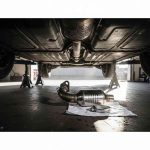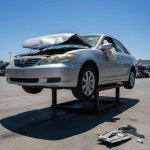If you’re a car owner, you’ve probably experienced the sudden illumination of the “check engine” light on your dashboard. This little amber icon can trigger a wave of worry, especially if you’re not sure what it means or what to do about it. In this article, we’ll delve into the reasons behind the activation of the check engine light and how to diagnose the issues it might be signaling.
Check Engine Light Quick Facts
The check engine light, also known as the malfunction indicator lamp, is a signal from your vehicles computer that something is wrong. It could be a minor issue, like a loose gas cap, or something more serious that requires immediate attention. The light could either be steady, indicating a non-emergency issue, or flashing, which warns of severe situations requiring immediate attention.
One of the most common misconceptions about the check engine light is that it only concerns the engine. In reality, this light could be triggered by a variety of issues, not all of them directly related to the engine. It’s essentially a way for your car to communicate that it needs some attention, and it’s always best to investigate the cause sooner rather than later.
If you’re interested in learning more about the check engine light and other car-related topics, check out our video tutorials or visit our junkyards near me page for more information.
What Makes a Check Engine Light Come On
The check engine light is connected to your car’s onboard diagnostics system (OBD-II). This system monitors various aspects of your vehicle’s performance, including the engine, transmission, emission system, and other key components. When the OBD-II system detects a problem that could affect your car’s emissions, performance, or longevity, it turns on the check engine light.
There are numerous reasons why the check engine light might come on. Some of the most common causes include a malfunctioning oxygen sensor, a loose or damaged gas cap, a faulty catalytic converter, or problems with the ignition coils or spark plugs.
If you’re looking for used auto parts to fix your vehicles, you might want to check out our local U-Pull-It auto salvage yard for discounted used car parts.
Check Engine Light Warning
While a steady check engine light is a cause for concern, a flashing check engine light is a clear sign of a severe problem that needs immediate attention. This could indicate a serious engine misfire, which could lead to damage to the catalytic converter – a costly component to replace.
If your check engine light starts flashing, it’s recommended to reduce your speed, avoid heavy acceleration, and get your vehicle checked by a professional mechanic as soon as possible.
For more information on car repairs and maintenance, visit our why do car parts and car repair cost so much in the USA page.
Never Ignore The Check Engine Light
Ignoring your check engine light can lead to more serious problems down the road. Even if the issue is minor, like a loose gas cap, leaving it unresolved could lead to more significant problems, like a damaged catalytic converter or even engine failure.
Remember, your vehicle is a complex machine, and every part plays a crucial role in its overall performance and longevity. Ignoring warning signs like the check engine light can lead to costly repairs and could even jeopardize your safety on the road.

How to Diagnose the Dashboard Warning Check Engine Light
If your check engine light comes on, the first thing you should do is check for any obvious issues, like a loose gas cap. If that’s not the problem, you’ll need to use an OBD-II scanner to read the trouble codes stored in your car’s computer. These codes can give you a better idea of what’s causing the problem.
You can purchase an OBD-II scanner online or at an auto parts store, or you can take your car to a mechanic or auto parts store that offers free code reading services. Once you have the codes, you can look them up online or consult a mechanic to understand what they mean.
Remember, while an OBD-II scanner can help identify the issue, it doesn’t replace a thorough inspection by a professional mechanic. If you’re not comfortable diagnosing and fixing the problem yourself, it’s always best to take your car to a professional.
How to Reset Check Engine Light
Once you’ve addressed the issue causing your check engine light to come on, you can reset the light. In many cases, the light will turn off on its own once the problem has been fixed. However, if the light remains on, you can use an OBD-II scanner to clear the codes and reset the light.
Keep in mind that resetting the check engine light without fixing the underlying problem is not a solution. The light will likely come back on, and you could be causing further damage to your vehicle.
What Makes a Check Engine Light Come On
The check engine light, also known as the malfunction indicator lamp, is a key part of your vehicle’s onboard diagnostic system (OBD-II). When this light comes on, it’s a clear sign that something is not right with the engine or another component of your vehicle. But what exactly triggers this warning light?
The answer lies in the myriad of sensors that are constantly monitoring your vehicle’s performance. These sensors are designed to detect anything from minor issues like a loose gas cap to major problems like a failing catalytic converter. When they detect an issue, they send a trouble code to the vehicle’s computer, which in turn illuminates the check engine light.
It’s important to note that a steady check engine light usually indicates a non-emergency issue. However, if the light is flashing, it’s a warning of a severe situation that requires immediate attention. Ignoring a flashing check engine light could lead to serious engine damage and costly repairs.
Common causes of a check engine light include:
- Loose or damaged gas cap: This is one of the simplest and most common reasons for a check engine light. If your gas cap is not properly tightened, or if it’s damaged, it can cause fuel vapors to leak out and trigger the light.
- Faulty oxygen sensor: The oxygen sensor measures the amount of unburned oxygen in your vehicle’s exhaust system. If this sensor is faulty, it can cause your engine to burn more fuel than necessary, leading to poor fuel economy and increased emissions.
- Bad spark plug or spark plug wires: Spark plugs ignite the air/fuel mixture in your engine’s combustion chamber, while spark plug wires deliver the electrical current to the spark plugs. If either of these components is worn out or damaged, it can cause your engine to misfire, which will trigger the check engine light.
- Failing catalytic converter: The catalytic converter reduces harmful emissions from your vehicle’s exhaust. If it’s failing, not only will your check engine light come on, but your vehicle may also run at a higher temperature and you may notice a decrease in fuel efficiency.
- Malfunctioning Mass Airflow Sensor (MAF): The MAF sensor measures the amount of air entering the engine and determines how much fuel is needed to run your engine efficiently. If the MAF sensor is malfunctioning, it can cause a variety of problems, including a decrease in gas mileage, acceleration issues, and a stalling engine.
Remember, these are just a few examples of what can cause your check engine light to come on. There are many other potential issues that can trigger this warning light. That’s why it’s so important to have your vehicle inspected by a certified mechanic when your check engine light comes on. They can use a special scan tool to read the trouble code(s) from your vehicle’s computer and determine exactly what’s causing the problem.
If you’re a do-it-yourselfer, you might be interested in learning how to diagnose check engine light problems yourself. Check out our video tutorials for some helpful tips and tricks. And if you need to replace any faulty parts, be sure to visit our local U-Pull-It auto salvage yard for discounted used car parts.
The Role of the Gas Cap and Other Common Issues

The Gas Cap: A Small Part with a Big Impact
You might be surprised to learn that a loose or damaged gas cap can trigger your check engine light. This small component is crucial for sealing the fuel system and maintaining pressure within the fuel tank. It also prevents gasoline fumes (hydrocarbons) from being released into the atmosphere while the car isn’t running. If your gas cap is loose, damaged, or missing, fuel can evaporate, causing your vehicle’s engine light to come on.
Other Common Problems
Other common problems that can cause the check engine light to illuminate include a faulty oxygen sensor, a failing catalytic converter, or worn-out spark plugs and wires. The oxygen sensor measures the amount of unburnt oxygen in your vehicle’s exhaust system. If it’s not working correctly, it can cause your engine to burn more fuel than necessary, leading to poor fuel economy and increased emissions.
The catalytic converter, an essential part of your vehicle’s emissions control system, converts harmful gases produced by the engine into less harmful substances. If it’s failing, you’ll notice a decrease in gas mileage and reduced engine performance.
Spark plugs ignite the air/fuel mixture in the combustion chamber, while spark plug wires deliver the spark from the ignition coil to the plugs. If these components are worn out or damaged, your engine may misfire, run roughly, or have difficulty starting.
The Importance of Regular Maintenance
Regular maintenance is key to preventing these and other issues that can cause your check engine light to come on. By keeping up with your vehicle’s recommended maintenance schedule and addressing problems as soon as they arise, you can keep your car running smoothly and avoid costly repairs down the road.
When to Seek Professional Help
While some issues can be diagnosed and fixed at home, others require the expertise of a professional mechanic. If your check engine light comes on and you’re unable to identify the cause, it’s best to take your vehicle to a trusted auto repair shop. They have the tools and knowledge to diagnose and fix the problem, ensuring your vehicle is safe and reliable on the road.
Diagnosing Check Engine Light Problems and Turning It Off
After understanding the common causes of the check engine light, it’s crucial to know how to diagnose these problems and turn off the light. The check engine light is connected to your vehicle’s onboard diagnostics system (OBD-II). This system is a complex piece of machinery that monitors and manages your vehicle’s performance. When the check engine light comes on, it means the OBD-II system has detected an issue.
To diagnose the problem, you’ll need an OBD-II scanner, a handy tool that can read the trouble codes from your vehicle’s computer. These codes provide information about what’s wrong with your vehicle. You can purchase an OBD-II scanner at an auto parts store near you, or you can rent one. Some auto parts stores even offer free check engine light diagnostics.
Once you’ve got the trouble codes, you can look them up online or in a repair manual to understand what they mean. However, it’s important to remember that these codes are just starting points. They tell you the system or component that’s not working correctly, but they don’t tell you why. For example, if you have a code for a misfire in cylinder 3, it doesn’t tell you if the problem is a spark plug, fuel injector, or something else.
After diagnosing and fixing the problem, the check engine light should turn off. If it doesn’t, you may need to use the OBD-II scanner to clear the codes. However, if the underlying problem hasn’t been fixed, the light will come back on.
Remember, while some check engine light problems are minor, others can lead to serious damage if not addressed promptly. If you’re not comfortable diagnosing or fixing the problem yourself, it’s best to take your vehicle to a certified mechanic or an auto repair shop.
Frequently Asked Questions
Can you drive your car with the check engine light on?
Yes, you can, but it’s not recommended. The check engine light is a warning that something is wrong with your vehicle. While it might be a minor issue, it could also be a serious problem that could cause damage if not addressed promptly.
What does check engine light flashing mean?
A flashing check engine light is serious. It usually indicates a severe engine misfire, which can cause damage to your vehicle’s catalytic converter. If your check engine light is flashing, you should stop driving as soon as it’s safe to do so and have your vehicle inspected immediately.
Why is OBD-II written as OBD2 or OBDII?
OBD-II, OBD2, and OBDII all refer to the same thing: the second generation of On-Board Diagnostics. This system monitors your vehicle’s performance and can alert you to problems.
Can I rent a check engine light reader?
Yes, many auto parts stores offer OBD-II scanner rentals. Some even offer free check engine light diagnostics.
In conclusion, the check engine light is a valuable tool that can alert you to problems with your vehicle. By understanding what causes the light to come on and how to diagnose the problems, you can keep your vehicle running smoothly and avoid costly repairs. Remember, if you’re ever in doubt, it’s best to consult with a professional.
Is the check engine light serious?
Yes, the check engine light is serious as it indicates a problem with your vehicle’s engine. This could be a minor issue like a loose gas cap or a major problem like a malfunctioning catalytic converter.
Is it safe to drive your car with the check engine light on?
It depends on the nature of the problem. If the check engine light is flashing, it indicates a severe issue, and you should stop driving immediately to prevent damage. If the light is steady, it’s less urgent but still important to get it checked out as soon as possible.
What could cause a check engine light to come on?
There are numerous reasons why a check engine light might come on. Some common causes include a malfunctioning oxygen sensor, a loose or damaged gas cap, a bad catalytic converter, faulty spark plugs, or a malfunctioning mass airflow sensor.
Is it OK to drive with check engine light on?
If the check engine light is steady, it’s typically okay to drive for a short distance, but you should get your vehicle inspected as soon as possible. If the light is flashing, you should stop driving immediately as this indicates a severe issue that could cause damage to the engine.
How serious is a solid check engine light?
A solid check engine light is a sign that there’s an issue with your vehicle, but it’s typically less urgent than a flashing light. However, it’s still important to get your vehicle inspected to prevent potential damage or more serious issues down the line.
How do I fix my check engine light?
Fixing a check engine light involves diagnosing the specific issue causing the light to come on. This typically involves using an OBD-II scanner to read the trouble code(s) stored in the vehicle’s computer. Once the problem has been identified, it can be fixed, which could involve anything from tightening a loose gas cap to replacing a faulty sensor or component. It’s generally recommended to have a professional mechanic diagnose and fix the issue.
Remember to visit our junkyard directory for all your used auto parts needs, and check out our video tutorials for more helpful tips on car maintenance and repair.
Conclusion
The check engine light is a crucial feature of your vehicle that helps alert you to potential problems. While it can be alarming to see this light come on, understanding what it means and how to respond can help you address issues promptly and maintain the health and performance of your vehicle.
Remember, ignoring the check engine light can lead to more serious problems down the road. If you’re unsure about what’s causing the light to come on or how to fix it, it’s always best to consult a professional mechanic.




